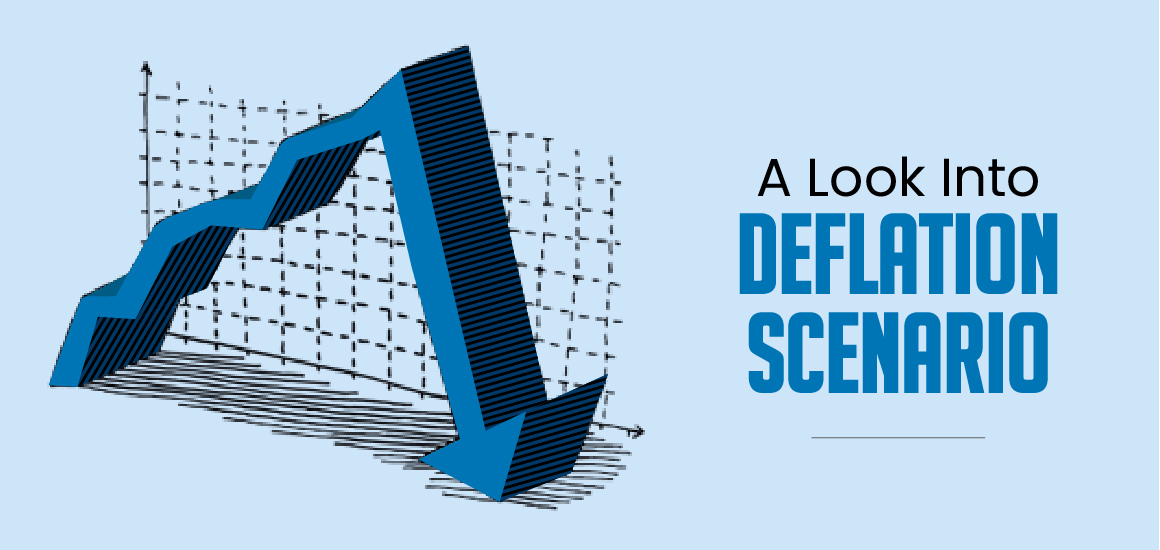When the prices are high, the natural tendency to wait for the prices to drop is the consumer’s purchasing behavior. Apple rolling out such offers every time you wait is such a great deal to receive. But did you know the prices of the products can still be falling and it gives the money increased purchasing power during the time of deflation? There is a downside to it as well as it’s not as straightforward as it seems. Deflation is worse than Inflation for a reason. That’s why you need a look into the “Deflation Scenario”.
What is Deflation?
The term also referred to as negative inflation is a “Dip in the price of the consumer goods over a period of time due to shrinking credit in the economy while it increases the purchasing power”.
Technically what seems like a great deal for a shorter time is a signal of the arrival of an economic crisis in a long time. Well, on the other hand, deflation can still be a good one if it is caused by “Innovation”, and that’s entirely a different story.
The short catch of the scenario
Interestingly when the power of purchasing is increased, the saved money seems like a lot to buy more products for their fallen prices but yet waiting for it to drop more eventually leads to saving money in the banks. Where there is a decrease in demand and no selling.
The longer catch of the scenario
Sadly, the decline in the demand for the goods due to the psychology of expecting, even more, dip in prices, in turn, reduces the wages of the employees or even leads to unemployment. That puts people to default on their debt repayments. There is poor circulation of money in the economy causing stagnation and leaving a feeling of being no longer rich.
Regaining the demand back into the system during deflation is much harder than spending more during inflation. The fall in price can’t go lower than zeroing it out, again putting people into the trap of spending less due to unemployment. That’s why deflation is worse than Inflation.
How is it when the world is in recession?
What puts the economy in Deflation?
1. The decline in demand
The central banks increase the interest rate, in that case, saving looks more lucrative than spending for a consumer, while borrowing money puts them into having to repay higher interest rates. In this context, people are into saving more than spending. So where is the demand? It is reducing.
2. The rise in supply
Technological advances have made the production cost much lower than what we experienced back in time. If the price of the inputs to make a finished good is lower, then the output is lower too which in return can oversupply but there wouldn’t be much demand to sell.
This forces the manufacturers to sell it at lower prices to increase the demand and on the other hand, the increased competition in the market makes the producers sell it at the most competitive lesser prices.
How do you think the government tackles deflation in the economy?
There are a few identified ways to tackle this but mentioning a few, so this scenario is well comprehended.
1. Cut down taxes
Government levies taxes for economic development. But in the crisis of recession due to deflation, the government can cut down taxes so that consumers can save and spend that money instead of giving it to the tax. That indeed curbs the government from collecting taxes and spending them on basic amenities during that course of time.
2. Lowering the interest rates
When the interest rate is high, it causes both consumers and businesses to borrow money harder. Even when the financial sector wants to borrow, it costs them more. For the economy to be functioning, it’s essential to bring down the interest rates to keep them engaged in investments.
3. Government pitching to spend
When there is no circulating money in the ecosystem, neither the businesses have the money nor the people. The deflationary scenario can be pulled out from the government by pouring in money to the businesses to allow them to continue until the economy recovers with the increasing demand.
Did you know about the hidden form of inflation?
Of all, how to assess the approach of deflation?
The most important question out of all is how to identify the arrival of deflation. The consumer price index is an indicator used to track both inflation and deflation conditions. The price of commonly used goods and services are under view every month and the change in prices being lower reflects deflation.
And this indicator may not be applicable in most applications such as housing prices and many others.
Real Tale – The Great Depression
This has been one of the hard economic times for the US. It was 1929 when the recession came into play and slowly the demand for the goods declined. It depicted the effects of deflation in every other economy but longer in the US until 1942.
The effect came down on having to shut down the businesses, spike in unemployment rates, and fall in the wholesale price index.
That was a longer deflation time though…
Inference from the view
The deflation scenario is a rare thing to occur but when it does, the hit is harder than the inflation, such that it takes a longer time to recover, meaning creating demand after a decline is a tougher time but eventually that must happen. The downturn can be so bad that the consumers don’t want to spend at all if it persists longer, though it all started alluring initially to wait for the prices to drop so that you could purchase later.
The actual scenario in reality is harder to digest, but this is something you must know.







